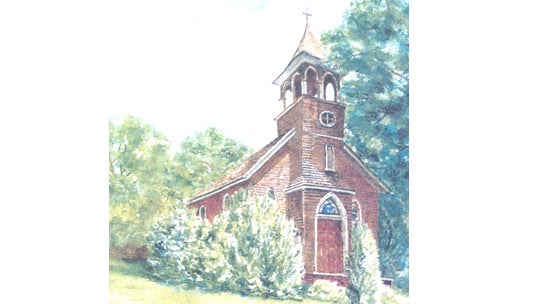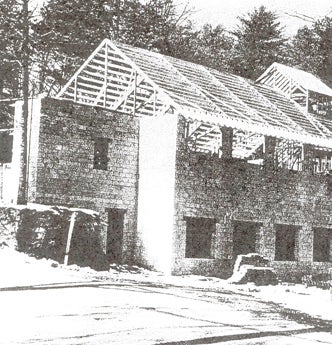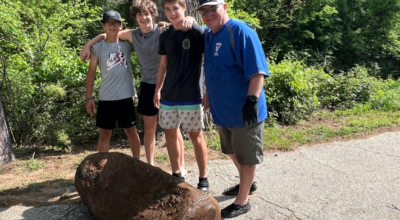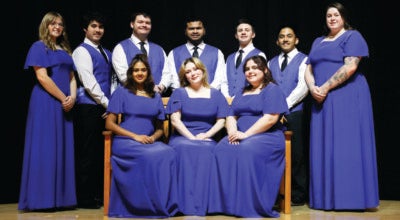St. John the Baptist marks 100 years
Published 9:20 am Friday, September 2, 2011
Italian feast set for Sept. 10 as part of year’s celebration
St. John the Baptist Catholic Church, located on Laurel Ave. in Tryon, celebrates its 100th anniversary this year.
The seeds that grew into St. John the Baptist Catholic Church in Tryon were planted in the 1800s, before television, radio, talking movies and World Wars I and II, and long before cell phones and computers.
The local Catholic population at the time consisted of six individuals. There were fewer Catholics in the Carolinas than in any other populated region in the country. In 1850, Catholics in both the Carolinas, which made up the Charleston Diocese, numbered less than 5,000, served by a total of six priests.
The original church site was dedicated on Oct. 22, 1911. The cornerstone was sealed into the bell tower and is the only known piece of the frame structure that remains today.
St. John’s was the first church built in a new ecclesiastical jurisdiction west of Charlotte. Belmont Abbey administered to the eight-county area. This was not a diocese but functioned as one under Belmont Abbey, which was Benedictine in its rule and order of priests. The abbott, Leo Haid, O.S.B. also served as bishop. St. John’s was under the care of the abbey’s Benedictine fathers from 1911 to 1944.
St. John’s remained a mission parish until it was brought into the Raleigh Diocese. The abbey priests would come to Tryon on Saturday and catch the noon train back to the abbey. There was no parking lot. The church had stained glass windows, but there was no rectory in the plans at that time.
An abbey newsletter stated that Tryon is one of the most delightful places to live, as nature favored it with mild temperatures and a climate ideal for convalescence and healthy living. Many semi-retired and retired people settled here.
The basic cost for the brown Gothic-style church was $2,225. The building measured 28 feet across and the front was about 49 feet long; it was built on a stone foundation. The basement housed a coal furnace and the bell-tower rose directly above the entrance of the church.
This was the only Catholic church in the 234 square miles of Polk County. Abbot Bishop Haid celebrated Mass and later that day there was a banquet held at Oak Hall Hotel (where Oak Hall condominiums stand now). Growth was meager in those years at St. John’s and the parish only grew to 12 people.
Rectory built
Then in 1923, when Father James Manley was pastor, a rectory was built. Father Manley was enthusiastic about the building of the rectory and refurbishing the church grounds. There was no sidewalk or cement walk approaching the church and those were of primary concern to Father Manley.
The ladies of the church decorated the altar with flowers and cleaned and cleaned the building. Mrs. Powers made a communion cloth for the railing and instead of an oilcloth, a carpet covered the aisle from the door to the sanctuary. Pews and woodwork were touched with varnish. Calcimine was placed on the walls. A Protestant gentleman offered paint for the exterior and new windows were installed.
Plans for the new rectory were drawn up by the Belmont Abbey architect, Father McInery, who designed the church 12 years earlier. The low bid for labor was $950. Father Manley provided the materials, buying lumber from whomever offered it at the best price. He purchased lumber for $30 per thousand board feet and paid $100 for the best oak flooring.
The rectory was a two-story wooden building 25×36 feet with a full basement. It was located behind the church where the parking lot is today. On the first floor was a vestibule, hall, living room, dining room, dining alcove, sun parlor and kitchen. On the second floor were three bedrooms, a sleeping porch, and a bathroom. The total cost was $3,700. Another $300 was used for ground furnishings and improvements. The heating system from St. Lawrence Church in Asheville cost $25.
The rectory was occupied principally by a parish family or a caretaker from 1924-1944; in 1944 Father Vincent Mahoney became pastor. The Benedictines always resided at the abbey, but Father Mahoney lived at the rectory at St. John’s.
Father Florian Checkhart, O.S.B. had the longest pastorate and frequently spent his weekends here at a guest’s home. He was taken to a movie on Saturday nights at the local theater; the film on Saturday nights was always a western.
The old rectory was occupied by St. John’s pastors from 1944-1960. Father Joseph Kerin became pastor in 1960 and also continued his duties in Asheville as principal of the Asheville Catholic High School. He also became chancellor of the Charlotte Diocese.
Growth of church
St. John’s experienced slow growth in its early years. Many Sundays saw about six worshippers at Mass. Father Manley said sometimes he had a crowd (12-14), including those who come from Spartanburg as they are going to the mountains for the day.
A 1914 annual report noted that the offertory collections totaled to $93.30 for that year. Special collections also produced another $9.40. The report showed a parish membership of 10. A small monthly income was then derived from renting the rectory.
In the 1960s and 1970s the church membership began to rise as retirees moved into the area from the northern states. During the short pastorate of Msgr. John F. Roueche, the number climbed to 80; in 1975, when he left, the number was 130.
Tryon remained in the Raleigh Diocese from 1944 until it was assigned in the newly established diocese of Charlotte in 1972. The first diocese here was that of Baltimore from 1789-1820; then came the Charleston Diocese from 1820-1868. Then followed the Vicarate Apostolic of North Carolina from 1868-1910. Then followed the Belmont Abbey jurisdiction from 1910-1944.
Fire destroys original church
The original building of St. John’s lasted about 48 years. On the early afternoon of June 25, 1959, the entire interior of the church collapsed in flames.
The fire began a little after 11 a.m. At 11:30 a.m., Father Francis McCourt, pastor, was talking on the rectory telephone when he glanced out the window and saw smoke pouring through the roof of the church. The week before a fundraising effort for a new roof had yielded $2,000.
Several neighbors saw the smoke and turned on the fire alarm. Finding the phone lines jammed and not being able to get through to the fire department, Father McCourt grabbed a fire extinguisher and ran to the church. Mr. H.S. Viner, who lived nearby, hooked up a garden hose.
The fire department finally arrived and brought the blaze under control, preventing it from spreading to the rectory only a few feet away. The result of recent rains and dampness of the area helped contain the fire. The new fire resistant roof kept the flames contained to the inside, as the exterior remained intact.
The building was a total loss, and it came just one day after the great feast of St. John the Baptist, patron saint of the church.
Father McCourt, with the help of a few neighbors, managed to salvage a few items from the fiery rubble, including sacred vessels and vestments. Only $12,000 of the loss was covered by insurance. It was estimated that $35,000 – $50,000 was needed to rebuild.
The rectory was untouched by the fire, but what remained inside the church were mostly blackened pews and twisted shingles and all the smashed boards of the collapsed roof. The organ, a gift from Abbott Haid, was demolished. From its tower over the entrance, the bell tore loose and crashed onto the front steps. Then it mysteriously disappeared and no one to this day knows what happened to it.
The fire was stated to be of undetermined origin. But one report cited that it was due to faulty wiring in the organ loft.
After the fire
The rectory was used for Sunday Mass after the fire, and two Protestant churches nearby also offered the use of their facilities.
This is how the rectory served its parishioners for the next three years. An altar was erected in the sun porch. The congregation gathered in the living room and dining room; when summer brought more visitors, the hall and vestibule were also filled for Mass.
Rebuilding the church
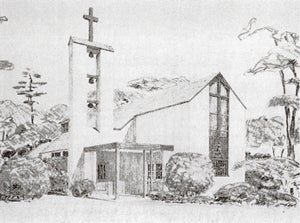
Architect’s drawing of the new St. John the Baptist Catholic Church in Tryon. The original church burned on June 25, 1959.
From the ashes of the fire came many friendly community gestures. Offers of money, materials and personal help flowed in from local churches, organizations and individuals throughout Tryon. Ladies at the Holy Cross Episcopal Church spent hours sewing draperies for the rectory. Burt Hopkins, of Holy Cross, made good use of his workshop at home to build an altar for the rectory for offering Mass.
Fundraising efforts began immediately, with the Ladies Altar Society, parishioners, friends and a contribution of $10,000 from the Catholic Extension Society all helping in the construction of the new church. The Ladies Altar Society also donated $250 for a new altar.
Plans for the new building were drawn up by Ernst A. Benkert, formerly of Chicago. He also designed the Tryon Fine Arts Center.
One of the many innovations that Mr. Benkert introduced was the lighting. Natural lighting was produced on the altar by an array of glass panels installed in the roof directly overhead. Attached to the wall near the stairs to the choir loft is a plaque in memory of his granddaughter, Ann Kyle Benkert, who died in infancy, on January 4, 1962, when the new church was under construction.
General contractor for the new church was Charles A. Lankford. Local labor and local building materials were used to the maximum extent possible throughout the construction.
There was a groundbreaking ceremony on Sunday, Sept. 24, 1961. The baptismal font, altar, altar railing, pews and all the cabinets in the sacristy were designed by Mr. Benkert and crafted by Leonard Porter. Retaining walls were laid by R.M.Searcy, using stones gathered from the Pacolet River. Vollmer Nurseries did the landscaping. Total cost for the new church was $60,000. The debt was retired in 1965.
New rectory purchased
The old rectory soon fell into disrepair. It never recovered from the extraordinary use it received in the three years use for Mass when it served as a parish church.
It was taken down in 1967 when the present rectory was purchased by Msgr. Peter McNerney, who became the first pastor to reside in the new rectory. He had previously lived in the parish hall for a few months as the old rectory had become uninhabitable.
Dedication of the new church was on Aug. 4, 1962. Mass was celebrated by Bishop Vincent Waters of Raleigh. Later a communion supper became the first planned event held in the parish hall. Mrs. John H. Duffy was the hostess. Father Kerin was a host to the other visitors who received a detailed look at the new church during an open house on Sunday afternoon, Aug. 5.
A new inscription was added later to the 1911 cornerstone with the name of the church and the initials O.P.M.(Omnia per Mariam) – All through Mary – the motto of Bishop Waters. There was some fear that the stone might crack at that time.
Church bells were expensive but a single bell was installed as a 75th anniversary gift and dedicated on Sunday, June 15, 1962.
Sealed inside the cornerstone are copies of the Tryon Daily Bulletin for Sept. 22 and 28, 1961, which contain photos and stories on the groundbreaking. Also there are portions of the Charlotte Observer and Philadelphia Catholic, both for Aug. 4, 1961, along with a medal of St. Benedict.
Renewed growth
St. John’s became an active parish. The oldest organization is the Ladies Altar Guild. By 1946 membership grew to 18 – which was a substantial number for a parish that drew fewer for Sunday Mass.
The guild of ladies was recognized upon the completion of the new church in 1962 with Mrs. Robert Shafer as its president. Mrs. Duffy was vice-president, Mrs. Lester Huton was secretary, and Mrs. Helen Andrews was treasurer.
In addition to maintaining the altar, providing flowers, conducting frequent coffee hours after Sunday Mass and supervising social activities as well as opening a telephone communication chain, the guild sponsored and held an annual bazaar. Held in late October, the bazaar featured a variety of handcrafted items made by the guild members. This event attracted people throughout the Tryon area and Landrum and Columbus and provided an important source of revenue for the church needs.
A men’s club was organized in 1984. John O’Conner was elected president, Joseph Hughes was secretary and John Moran was the program chairman. The club was dissolved in 1985.
A parish council was recognized and expanded in 1982. With Father Morse and Father Gavigan, the council brought about a reconditioning of the church grounds, including major improvements to the parking area (the upper lot was formerly unpaved and without steps or a railing).
New and brighter light for the church interior was installed, a new rood, upgrading of kitchen facilities in the parish hall, and renovations in the rectory were all addressed. A fourfold increase in offertory contributions made all these improvements possible.
Community outreach programs to serve the needy included the establishment of a food bank and the distribution of clothing. Parish ministry was extended to those who were home bound and shut-ins, and pastoral visits to all parishioners were 90 percent complete.
The pastors of St. John’s have always helped advance ecumenism in part through membership in the Tryon Ministerial Association. One result of these efforts in 1985 was the appearance of Father Richard Murphy, O.P., a Biblical scholar and one of the translators of the New American Bible. Father Murphy presented the parish with a well-received series of lectures at the Tryon Presbyterian Church.
Religious study programs have been strengthened at St. John’s under the leadership of Bruce Haslett, education chairman of the council, working with Father Morse and Father Gavigan. The programs enrolled some 25 young people. For adults, the parish offered a Catholic inquiry class and a class in Bible study.
In the liturgical ministry of St. John’s the parish enjoyed the support of a senior choir, three organists, seven altar servers, 11 Eucharistic ministers, 18 readers and 19 ushers. Nearly every member of the parish registered for service of some kind, liturgical or others.
As of 1986, the parish registry listed more than 180 households, representing more than 300 individuals plus 35 floating members. The outlook for a continued increase at this time was favorable as St. John’s became a growing parish and there was a rapid expansion of the Universal Catholic Church in the Carolinas.


